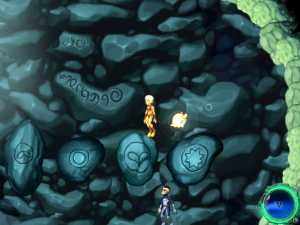CSotN: False Ending
Today, I beat Castlevania: Symphony of the Night. In a sense, anyway.
There was a boss fight against former hero Richter Belmont — I had been expecting Dracula, but when you think about it, Richter has already been established to be tougher than Dracula. The fight was kind of anticlimactic, over with disappointingly quickly. This is always a danger with RPG-like leveling systems that allow the player to keep on leveling beyond the point of challenge, but you’d think they could keep a bit of drama by making it a multi-stage boss. (It’s not like the notion was foreign to the designers. Dracula in the intro had two stages.) Victory was followed by an epilogue cutscene, and then the credits scrolled by, and ordinarily I’d consider that to be enough to get a game off the Stack. But, well, there were indications that I wasn’t actually finished with the game.
There were still passages I hadn’t yet found a way to get through, and even an optional miniboss that I hadn’t managed to beat. That in itself didn’t mean very much: there are a lot of blocked passages that just lead to a single room containing a piece of equipment or two, and in a lot of cases, I only found them after they had been rendered obsolete. But in the castle library, you can look at a sort of pokédex of all the monster types you’ve encountered, and something close to half the slots in the list were yet to be filled in. This made it seem like there had to be more than just a handful of isolated bonus rooms. The really convincing thing, though, was that the map showed a couple of small rooms on the opposite side of, and only accessible from, the room where the final boss fight took place. Which made them clearly impossible to get to, because you don’t get to leave that room: win or lose, the game ends there.
And so, jumping back to my last save before winning, I went to fight that one undefeated miniboss, a magician who summons swarms of bats and flying skulls. I had initially found this much harder than the fight against Richter, and I kind of wonder if this was deliberate, a way to encourage people to fight Richter first. But then, maybe not: after a little thought, I realized that there was a specific special weapon, a book that swirls around you in a defensive cloud, that would take down the swarms easily. Special weapons, the ones that use “hearts” for ammo, have the peculiar property that they don’t go into your inventory like most items, and you can only hold one at a time. It’s a weird mechanic for this game, but it’s one that Symphony of the Night inherited from the original Castlevania, which was just a platformer rather than a platformer/RPG(/adventure) hybrid and didn’t have an inventory. Anyway, it worked, and that led to an item that had obvious application to exploring another previously-unexplorable area, which turned out to hold another item that unlocked a different area, and so forth until I had a new way to handle the encounter with Richter, and, through it, access to those impossible rooms on the other side.
One of my vague wouldn’t-it-be-interesting game ideas that I’ll probably never actually implement is the idea of a game with a secret. You’d have a straightforward quest: rescue the princess, say. You could complete this quest by playing the game in the obvious way, and some people would do that and be satisfied. But other people would put together some details and realize that rescuing the princess isn’t what they should actually be doing: the royal family are all secretly alien shapeshifters, perhaps, and the player characters who win the straightforward way will wind up with their brains sucked out of their skulls while the credits are rolling. The people who discover this would have an opportunity to go off the obvious path and wind up playing a larger game, with different goals.
There are a few games that approach this to various degrees, but none I’m aware of quite reach it. Portal does the subversion, but forces the player into it. The Path lets you either pursue your stated goal the simple and direct way or wander the world around first, but doing the former is explicitly unsatisfactory. Gregory Weir’s The Day has two very different stories wrapped up into a single game, but it doesn’t make a secret of the fact.
Castlevania: Symphony of the Night may be the closest thing to the concept I’ve seen. I really can imagine someone defeating Richter and putting the game away, satisfied that they’ve finished it. But I can’t, now that I know the fuller story, that Richter isn’t the bad guy after all, and now that I’ve seen what’s on the other side of that room. Which I will describe in my next post. All I’ll say for now is that I’m very glad that I didn’t accept the false ending. Pursuing the game further has replaced anticlimax and disappointment with open-mouthed delight.
 Comments(1)
Comments(1)